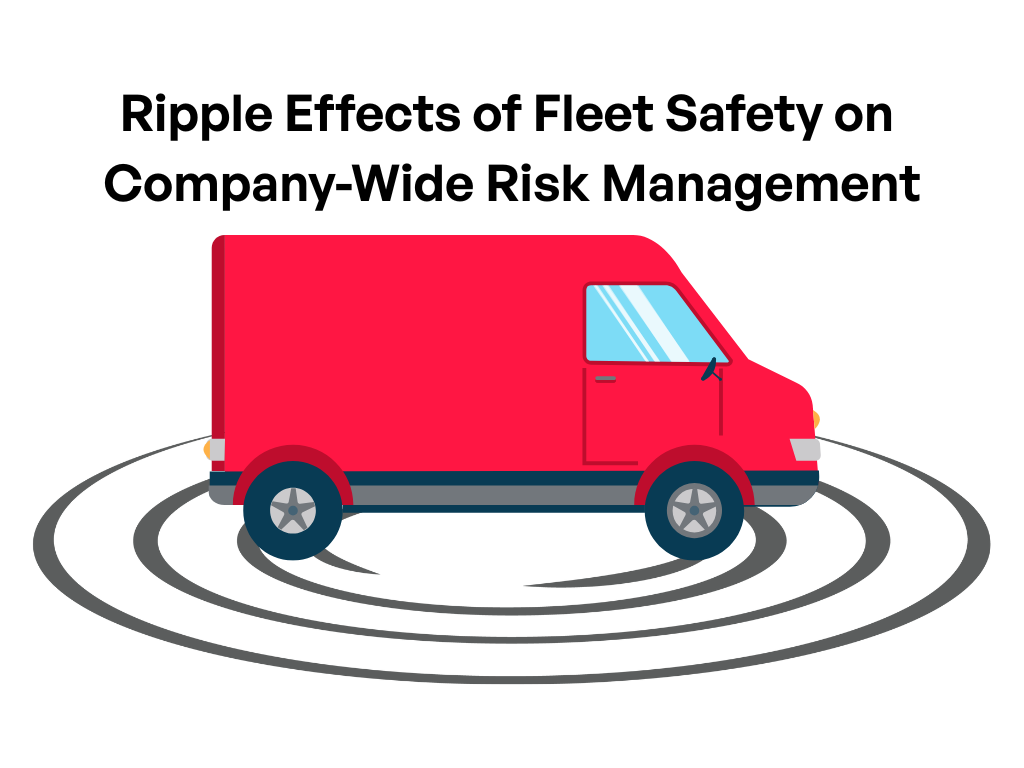
The Ripple Effects of Fleet Safety on Company-Wide Risk Management
When most Environmental, Health, and Safety (EHS) professionals think about risk management, their minds go to facility hazards, regulatory compliance, or incident reporting. But one of the largest and often most overlooked sources of organizational risk is right on the road.
Whether it’s a handful of service vans or a nationwide delivery fleet, every vehicle represents moving risk exposure. A robust fleet safety program doesn’t just protect drivers, it strengthens the entire organization’s risk management posture. In fact, the ripple effects of a safe, well-managed fleet extend across regulatory compliance, financial stability, operations, culture, and reputation.
In this article, we’ll explore how improving fleet safety reduces company-wide risk, how it connects to the discipline of Enterprise Risk Management (ERM), and practical steps EHS professionals can take to build those connections.
Why Fleet Safety Matters (Beyond the Driver)
According to the National Institute for Occupational Safety and Health ( https://archive.cdc.gov/www_cdc_gov/niosh/newsroom/feature/fleetsafety.html ), motor vehicle crashes are the leading cause of work-related deaths in the United States. More than 29,000 workers died in work-related motor vehicle crashes between 2003 and 2018, accounting for nearly one in four workplace fatalities.
Fleet vehicles don’t only include long-haul trucks. Company cars, service vans, and even employee-owned vehicles used for business travel can all fall under fleet safety responsibilities. Each vehicle represents a potential point of risk that can ripple through the entire business.
A single collision can trigger a cascade of consequences:
● Regulatory exposure from reporting and compliance failures
● Insurance and legal claims that increase premiums
● Operational downtime impacting customer commitments
● Reputational damage and public scrutiny
● Employee morale issues and driver turnover
Addressing fleet safety, therefore, isn’t just about preventing accidents, it’s about preventing the downstream secondary risks that follow.
Fleet Safety as a Component of Enterprise Risk Management
Enterprise Risk Management (ERM) is an organization-wide framework for identifying, assessing, and controlling risks across all areas of a business: from financial and operational to compliance and safety.
For EHS professionals, thinking in ERM terms means asking: How do safety programs, including fleet safety, influence our company’s overall stability and strategic objectives?
Fleet safety aligns naturally with the core principles of ERM:
1. Risk Identification: Recognizing hazards related to driver behavior, vehicle maintenance, route conditions, and regulatory obligations.
2. Risk Assessment: Evaluating the likelihood and severity of incidents using metrics such as crash frequency and severity per miles driven.
3. Risk Mitigation: Implementing controls like telematics, driver training, and clear mobile-device policies.
4. Monitoring and Review: Tracking performance indicators and near-misses to ensure controls remain effective.
Research published in Safety Science backs this up: companies that demonstrate strong management commitment, fatigue awareness, and strict mobile-device policies experience significantly lower crash and injury rates compared to those that do not. ( https://www.sciencedirect.com/science/article/abs/pii/S0925753518320502?via%3Dihub )
Fleet risk also has a major financial dimension. U.S. businesses lose more than $60 billion annually due to fleet-related incidents, and a single accident involving injuries can cost an employer upwards of $74,000.
By integrating fleet safety into enterprise-level risk discussions, EHS professionals can better align with executive priorities and strengthen the organization’s resilience.
The Ripple Effects: Key Areas Impacted by Fleet Safety
1. Regulatory & Compliance Risk
Fleet operations fall under a web of federal and state regulations. For commercial operations, the Federal Motor Carrier Safety Administration (FMCSA) oversees compliance requirements around Hours-of-Service, vehicle inspections, and driver qualifications.
Failing to comply can result in fines, audits, and operational disruptions.
A strong fleet safety program not only keeps the organization compliant but also reduces audit frequency and improves CSA (Compliance, Safety, Accountability) scores.
Learn more: FMCSA CSA Overview ( https://www.fmcsa.dot.gov/safety/compliance-safety-accountability-csa )
2. Financial & Insurance Risk
Every accident has financial consequences: vehicle repairs, medical claims, lost productivity, and increased premiums.
A comprehensive fleet safety program directly reduces incident frequency and severity, which lowers insurance costs and litigation exposure. Proactive fleet risk management also drives cost efficiency, protects brand reputation, and improves driver and community safety.
EHS professionals who can quantify these savings and communicate them in financial terms help make the business case for ongoing investment in fleet safety technology and training.
3. Operational Risk & Business Continuity
A vehicle accident isn’t just a safety event; it’s a guaranteed operational disruption. Lost vehicles, driver injuries, or delayed shipments can affect customer relationships and contractual obligations. In industries like construction or field services, even one disabled vehicle can throw off entire project schedules.
Fleet safety practices such as routine vehicle inspections, real-time GPS tracking, and proactive maintenance scheduling support business continuity by minimizing unplanned downtime.
4. Human Capital & Culture Risk
Drivers are often the most visible ambassadors of a company’s safety culture. When drivers feel supported by fair policies, quality equipment, and meaningful feedback, it strengthens morale and reduces turnover.
Conversely, unclear expectations or inconsistent enforcement can lead to disengagement and riskier behavior.
NIOSH research confirms that management commitment and driver engagement are the two strongest predictors of reduced crash and injury rates in fleet operations.
By incorporating fleet safety into the broader safety culture, EHS leaders reinforce the message that safety isn’t just situational, it’s organizational.
5. Reputational & Contractual Risk
Fleet incidents can quickly become public events. A crash involving a company-branded vehicle can attract media coverage, social media attention, and reputational damage.
For companies that rely on contracts or public bids, safety performance records are often a selection criterion.
Demonstrating a strong fleet safety record improves eligibility for new contracts and strengthens stakeholder trust.
Linking Metrics & Data Across Fleet Safety and Enterprise Risk
One of the most effective ways to connect fleet safety to company-wide risk is through shared data and metrics.
Common fleet safety indicators include:
● Crash frequency and severity per million miles driven
● Harsh braking or acceleration events
● Speeding incidents
● Vehicle inspection compliance rates
● CSA (Compliance, Safety, Accountability) scores
We like the list and rationale proposed by Rhythm Innovations: Top 10 Fleet Safety Metrics
Integrating these metrics into your EHS or ERM dashboard enables leaders to see the full picture and how driver behavior trends align with other safety incidents, claims, and operational KPIs.
EHS professionals who can surface these correlations often uncover hidden risks and put forth interventions before they escalate.
Best Practices: Integrating Fleet Safety into Your EHS/ERM Program
You don’t need to be a fleet manager to build an effective fleet safety component into your EHS strategy. The following steps can help connect the dots:
1. Secure leadership buy-in. Present fleet safety as part of enterprise risk, not a standalone compliance activity.
2. Conduct a fleet risk assessment. Identify all vehicle types, driver profiles, and route risks. We like this fleet risk assessment guide curated by Fleetworthy. ( https://fleetworthy.com/blog/fleet-risk-assessment/ )
3. Develop clear policies and procedures. Include mobile-device bans, fatigue management, and vehicle maintenance schedules.
4. Leverage technology. Use telematics, AI-enabled dash cameras, or driver-coaching systems to monitor behavior and capture context. ( https://surecam.com/fleet-cameras/top-rated-dash-cams-with-ai/?pscd=join.surecam.com&ps_partner_key=MjUzZWFkZDAyOWMw&ps_xid=nOzOjdhjBnLAdO&gsxid=nOzOjdhjBnLAdO&gspk=MjUzZWFkZDAyOWMw )
5. Train and engage drivers. Safety meetings, recognition programs, and transparent feedback loops create alignment between office and road teams.
6. Track and report metrics. Feed fleet safety data into your EHS dashboards or quarterly risk reviews. For further guidance, review the Safety Knights guide on integrating fleet video data into your EHS management system. ( https://surecam.com/blog/integrating-fleet-video-data-into-your-ehms-strategy-best-practices )
7. Communicate success. Share improvements across departments to reinforce that fleet safety improvements benefit everyone from finance to HR to operations.
For EHS professionals managing multiple programs, these steps ensure fleet safety isn’t an isolated effort but an integrated part of company-wide risk management.
Challenges & Common Pitfalls
Even the best-intentioned fleet safety programs can stall if they’re siloed or under-resourced.
Common pitfalls include:
● Treating fleet safety as purely a driver-management issue instead of a business risk issue
● Limited data integration between fleet and EHS systems
● Lack of leadership engagement or cross-department collaboration
● Deploying technology without clear policies or follow-up training
Overcoming these challenges requires alignment. Establish a cross-functional steering committee that includes EHS, operations, fleet management, HR, and finance leaders. Align reporting cycles and shared metrics so that fleet risk data directly informs enterprise risk reporting.
Fleet Safety Risk Assessment Checklist for EHS Professionals
Use this quick checklist to assess your current program:
● Identify all vehicle types and driver exposures in your organization
● Map fleet-related risks to enterprise risk categories (financial, operational, compliance, reputational)
● Review and update fleet safety policies and training programs
● Select 3–5 key fleet safety metrics to report at the executive level
● Integrate fleet data into your EHS dashboard or quarterly reviews
● Schedule a cross-department review meeting to discuss fleet safety trends
● Set measurable targets (e.g., 15% reduction in harsh braking events in 12 months)
● Communicate wins to reinforce leadership support
Conclusion
At SureCam, we believe fleet safety is one of the most powerful levers a company has to reduce risk and protect its people. Every mile driven represents potential exposure, but also an opportunity to strengthen the organization’s safety culture, reduce financial risk, and build operational resilience.
For EHS professionals in the Safety Knights community, integrating fleet safety into enterprise risk management is a powerful way to elevate your role, connect safety to strategy, and drive measurable business impact.
This article is part of the Safety Knights community series in partnership with SureCam ( https://surecam.com/ ), designed to give EHS professionals practical insights into fleet safety, risk management, and compliance.
